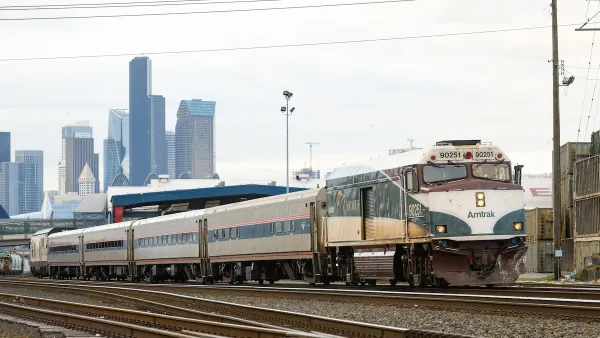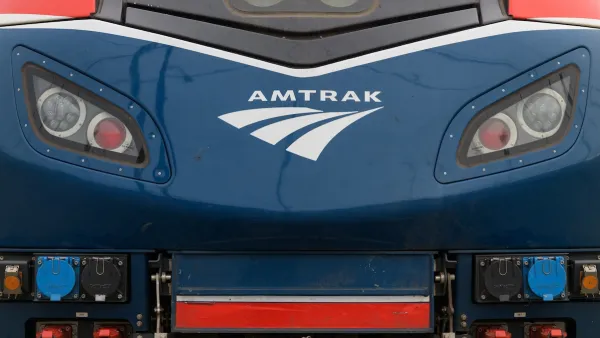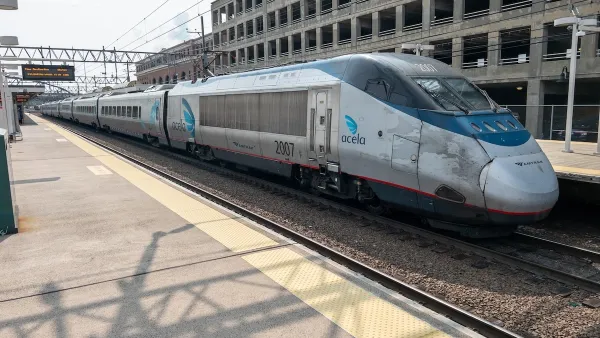"Ladies and gentlemen, welcome aboard Amtrak Train 715. We're expecting a smooth ride today and should be moving along right on time," said the voice of the train conductor over the loudspeaker. He then continued, "And thanks for joining us for National Train Day". The loudspeaker then turned off, and was followed instantly by the voice of an incredulous woman a few rows behind who said "What?"
"Ladies and gentlemen, welcome aboard Amtrak Train 715. We're expecting a smooth ride today and should be moving along right on time," said the voice of the train conductor over the loudspeaker. He then continued, "And thanks for joining us for National Train Day". The loudspeaker then turned off, and was followed instantly by the voice of an incredulous woman a few rows behind who said "What?"
What indeed. National Train Day?
Apparently there is such a thing. The first National Train Day took place May 10, 2008. It was held in honor of the "golden spike" that was driven to connect the Central Pacific and Union Pacific Railways on May 10, 1869, in Promontory Summit, Utah – creating the cross-country rail system so few of us use or even consider today.
And so it is. National Train Day in a country that all but abandoned the concept of rail transportation decades ago, and one that seems perpetually on the verge of cutting all funding to the struggling system. The Bush administration has proposed to cut Amtrak's budget by 40% in 2009, and legislators in congress are struggling to stop it from happening. Though ridership has been at record highs for the last five years, the system is still operating in the red.
I hadn't heard about National Train Day until I got on the train that day. Apparently, Amtrak was celebrating by hosting live music acts and events at the nation's four biggest stations: Washington, D.C.'s Union Station, New York City's Penn Station, Chicago's Union Station and Los Angeles' Union Station. Unless you were looking for these events, they were pretty easy to miss.
National Train Day seemed to slip under the radar of many riders on my train that day, the vast majority of whom were just trying to get from point A to point B. Maybe this is a failed holiday, or maybe it's a minor attempt at bringing some visibility to a form of transportation most Americans have never used. Whatever it is, it could stand to be more effective at bringing the idea of train transportation to the masses. Maybe they should have offered some free tickets to get people on board. Or maybe they should spread their promotional efforts out beyond one day to try to change the public's perception of the train from novelty to viable transportation option. Maybe, considering the current political climate, it's too late.
But there were some riders on my train who seemed to know it was National Train Day. They were two older men, presumably a man and his father, and each was toting a toddler, the third generation. This family of men was out for a ride to celebrate America's trains. They were touring the train in wonderment, each with National Train Day buttons stuck to their t-shirts. The two boys were crowned by conductor hats, printed out on cardstock and wrapped around their little heads. The men were holding then hands of the small boys, pointing out the window, stopping to look at the conductor taking tickets, and testing out the collection of empty seats. The men could also be overheard explaining the path of the train to the boys -- in thick British accents.
These four people, probably the only four people celebrating National Train Day in America, were British. If that doesn't tell you something about the role trains play in American life, hop on a train for next year's National Train Day. See if anyone else knows what day it is.

National Parks Layoffs Will Cause Communities to Lose Billions
Thousands of essential park workers were laid off this week, just before the busy spring break season.

Retro-silient?: America’s First “Eco-burb,” The Woodlands Turns 50
A master-planned community north of Houston offers lessons on green infrastructure and resilient design, but falls short of its founder’s lofty affordability and walkability goals.

Delivering for America Plan Will Downgrade Mail Service in at Least 49.5 Percent of Zip Codes
Republican and Democrat lawmakers criticize the plan for its disproportionate negative impact on rural communities.

Test News Post 1
This is a summary

Test News Headline 46
Test for the image on the front page.

Balancing Bombs and Butterflies: How the National Guard Protects a Rare Species
The National Guard at Fort Indiantown Gap uses GIS technology and land management strategies to balance military training with conservation efforts, ensuring the survival of the rare eastern regal fritillary butterfly.
Urban Design for Planners 1: Software Tools
This six-course series explores essential urban design concepts using open source software and equips planners with the tools they need to participate fully in the urban design process.
Planning for Universal Design
Learn the tools for implementing Universal Design in planning regulations.
EMC Planning Group, Inc.
Planetizen
Planetizen
Mpact (formerly Rail~Volution)
Great Falls Development Authority, Inc.
HUDs Office of Policy Development and Research
NYU Wagner Graduate School of Public Service





























